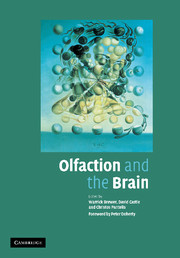Crossref Citations
This Book has been
cited by the following publications. This list is generated based on data provided by Crossref.
Dileo, J. F.
Brewer, W. J.
Hopwood, M.
Anderson, V.
and
Creamer, M.
2008.
Olfactory identification dysfunction, aggression and impulsivity in war veterans with post-traumatic stress disorder.
Psychological Medicine,
Vol. 38,
Issue. 4,
p.
523.
Sell, Charles S.
2008.
Wiley Encyclopedia of Chemical Biology.
p.
1.
Pantelis, Christos
Yücel, Murat
Wood, Stephen J.
Brewer, Warrick J.
Fornito, Alex
Berger, Gregor
Cannon, Tyrone
and
Velakoulis, Dennis
2009.
The Recognition and Management of Early Psychosis.
p.
61.
Berry, Yvette
2010.
Kirk-Othmer Encyclopedia of Chemical Technology.
p.
1.
Dudova, Iva
Vodicka, Jan
Havlovicova, Marketa
Sedlacek, Zdenek
Urbanek, Tomas
and
Hrdlicka, Michal
2011.
Odor detection threshold, but not odor identification, is impaired in children with autism.
European Child & Adolescent Psychiatry,
Vol. 20,
Issue. 7,
p.
333.
Murphy, Brendan P.
and
Brewer, Warrick J.
2011.
Early intervention in psychosis: clinical aspects of treatment.
Advances in Psychiatric Treatment,
Vol. 17,
Issue. 6,
p.
408.
Stevenson, Richard J.
2013.
Olfactory perception, cognition, and dysfunction in humans.
WIREs Cognitive Science,
Vol. 4,
Issue. 3,
p.
273.
Singh, Prashant
and
Yadava, R D S
2013.
Enhancing chemical identification efficiency by SAW sensor transients through a data enrichment and information fusion strategy—a simulation study.
Measurement Science and Technology,
Vol. 24,
Issue. 5,
p.
055109.
Schecklmann, Martin
Schwenck, Christina
Taurines, Regina
Freitag, Christine
Warnke, Andreas
Gerlach, Manfred
and
Romanos, Marcel
2013.
A systematic review on olfaction in child and adolescent psychiatric disorders.
Journal of Neural Transmission,
Vol. 120,
Issue. 1,
p.
121.
Garcia-Esparcia, Paula
Schlüter, Agatha
Carmona, Margarita
Moreno, Jesús
Ansoleaga, Belen
Torrejón-Escribano, Benjamín
Gustincich, Stefano
Pujol, Aurora
and
Ferrer, Isidre
2013.
Functional Genomics Reveals Dysregulation of Cortical Olfactory Receptors in Parkinson Disease: Novel Putative Chemoreceptors in the Human Brain.
Journal of Neuropathology & Experimental Neurology,
Vol. 72,
Issue. 6,
p.
524.
Ferrer, Isidro
Garcia-Esparcia, Paula
Carmona, Margarita
Carro, Eva
Aronica, Eleonora
Kovacs, Gabor G.
Grison, Alice
and
Gustincich, Stefano
2016.
Olfactory Receptors in Non-Chemosensory Organs: The Nervous System in Health and Disease.
Frontiers in Aging Neuroscience,
Vol. 8,
Issue. ,
Bewley, Anthony
and
Taylor, Ruth E.
2016.
Rook's Textbook of Dermatology, Ninth Edition.
p.
1.
Kumazaki, Hirokazu
Muramatsu, Taro
Fujisawa, Takashi X.
Miyao, Masutomo
Matsuura, Eri
Okada, Ken-ichi
Kosaka, Hirotaka
Tomoda, Akemi
and
Mimura, Masaru
2016.
Assessment of olfactory detection thresholds in children with autism spectrum disorders using a pulse ejection system.
Molecular Autism,
Vol. 7,
Issue. 1,
Muratori, Filippo
Tonacci, Alessandro
Billeci, Lucia
Catalucci, Tiziana
Igliozzi, Roberta
Calderoni, Sara
and
Narzisi, Antonio
2017.
Olfactory Processing in Male Children with Autism: Atypical Odor Threshold and Identification.
Journal of Autism and Developmental Disorders,
Vol. 47,
Issue. 10,
p.
3243.
Dileo, J. F.
Brewer, W.
Northam, E.
Yucel, M.
and
Anderson, V.
2017.
Investigating the neurodevelopmental mediators of aggression in children with a history of child maltreatment:An exploratory field study.
Child Neuropsychology,
Vol. 23,
Issue. 6,
p.
655.
Fadda, Roberta
Piras, Francesco
Doneddu, Giuseppe
Saba, Luca
and
Masala, Carla
2018.
Olfactory Function Assessment in Italian Subjects with Autism Spectrum Disorder.
Chemosensory Perception,
Vol. 11,
Issue. 2,
p.
51.
Herman, Aleksandra M.
Critchley, Hugo
and
Duka, Theodora
2018.
Decreased olfactory discrimination is associated with impulsivity in healthy volunteers.
Scientific Reports,
Vol. 8,
Issue. 1,
Biswas, Dipayan
and
Szocs, Courtney
2019.
The Smell of Healthy Choices: Cross-Modal Sensory Compensation Effects of Ambient Scent on Food Purchases.
Journal of Marketing Research,
Vol. 56,
Issue. 1,
p.
123.
Challakere Ramaswamy, Vasudeva Murthy
and
Schofield, Peter William
2022.
Olfaction and Executive Cognitive Performance: A Systematic Review.
Frontiers in Psychology,
Vol. 13,
Issue. ,
Bewley, Anthony
and
Taylor, Ruth E.
2024.
Rook's Textbook of Dermatology.
p.
1.



